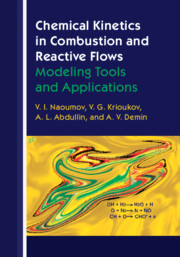Book contents
- Reviews
- Chemical Kinetics in Combustion and Reactive Flows
- Chemical Kinetics in Combustion and Reactive Flows
- Copyright page
- Dedication
- Contents
- Preface
- Acknowledgments
- Nomenclature
- Part I Basic Components of Chemical Nonequilibrium Models
- Part II Mathematical Modeling of Selected Typical Modes of Combustion
- 4 Laminar Premixed Flames: Simulation of Combustion in the Flame Front
- 5 Droplets and Particles: Evaporation in High-Temperature Flow and Combustion in Boundary Layers
- 6 Models of Droplet Evaporation in Gas Flow
- Part III Simulation of Combustion and Nonequilibrium Flows in Propulsion and Power Generation Systems
- References
- Index
4 - Laminar Premixed Flames: Simulation of Combustion in the Flame Front
from Part II - Mathematical Modeling of Selected Typical Modes of Combustion
Published online by Cambridge University Press: 16 August 2019
- Reviews
- Chemical Kinetics in Combustion and Reactive Flows
- Chemical Kinetics in Combustion and Reactive Flows
- Copyright page
- Dedication
- Contents
- Preface
- Acknowledgments
- Nomenclature
- Part I Basic Components of Chemical Nonequilibrium Models
- Part II Mathematical Modeling of Selected Typical Modes of Combustion
- 4 Laminar Premixed Flames: Simulation of Combustion in the Flame Front
- 5 Droplets and Particles: Evaporation in High-Temperature Flow and Combustion in Boundary Layers
- 6 Models of Droplet Evaporation in Gas Flow
- Part III Simulation of Combustion and Nonequilibrium Flows in Propulsion and Power Generation Systems
- References
- Index
Summary
The model of the combustion in the flame front is commonly used for the simulation of operating parameters and emission characteristics of combustion chambers of different combustion systems as one of the main simulation fragments in models of premixed flames. The typical scheme of combustion in the flame front was described in the Section 1.1. Combustion in the flame front predetermines to a considerable extent the further afterburning processes and parameters of reacting flows in the combustion unit and combustion products emission. In accordance with the generally accepted definition, the flame front is identified as a thin layer separating an unburned fresh mixture of the reactants from the combustion products wherein maximum gradients of concentrations of the reactants and reaction products are observed (Figure 4.1). Once the fresh mixture is ignited, a resulting premixed flame propagates in the x direction, consuming the unburned mixture. The chemical interaction in the flame front under conditions of intensive self-acceleration of the processes caused by the transfer of both heat and active catalyzing centers from the products of reactions to the unburned fresh mixture.
- Type
- Chapter
- Information
- Chemical Kinetics in Combustion and Reactive FlowsModeling Tools and Applications, pp. 207 - 227Publisher: Cambridge University PressPrint publication year: 2019



